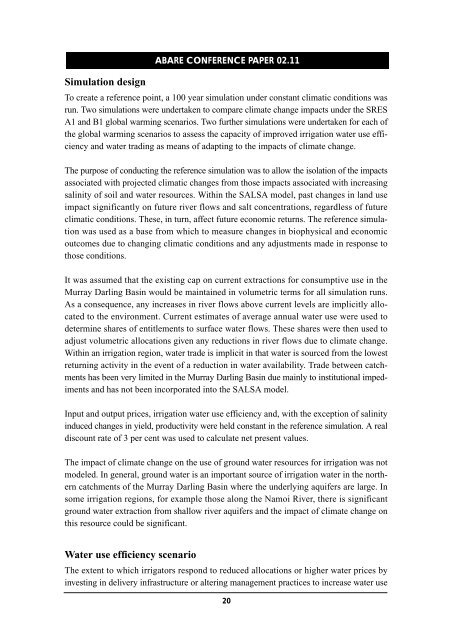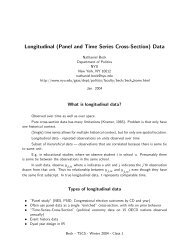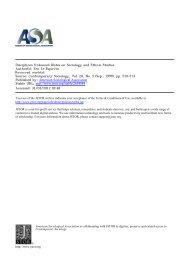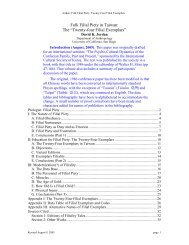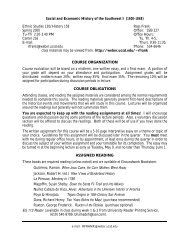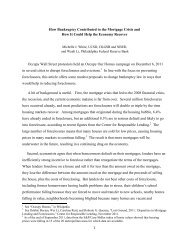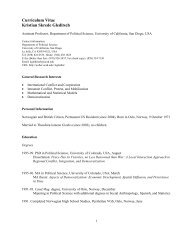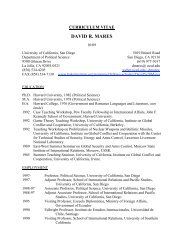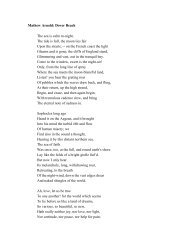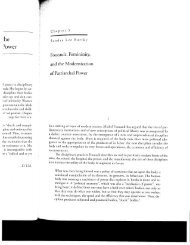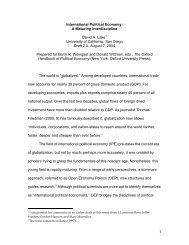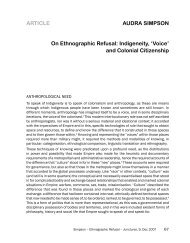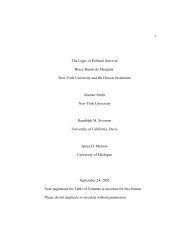Climate change and water resources in the Murray Darling Basin ...
Climate change and water resources in the Murray Darling Basin ...
Climate change and water resources in the Murray Darling Basin ...
You also want an ePaper? Increase the reach of your titles
YUMPU automatically turns print PDFs into web optimized ePapers that Google loves.
Simulation design<br />
ABARE CONFERENCE PAPER 02.11<br />
To create a reference po<strong>in</strong>t, a 100 year simulation under constant climatic conditions was<br />
run. Two simulations were undertaken to compare climate <strong>change</strong> impacts under <strong>the</strong> SRES<br />
A1 <strong>and</strong> B1 global warm<strong>in</strong>g scenarios. Two fur<strong>the</strong>r simulations were undertaken for each of<br />
<strong>the</strong> global warm<strong>in</strong>g scenarios to assess <strong>the</strong> capacity of improved irrigation <strong>water</strong> use efficiency<br />
<strong>and</strong> <strong>water</strong> trad<strong>in</strong>g as means of adapt<strong>in</strong>g to <strong>the</strong> impacts of climate <strong>change</strong>.<br />
The purpose of conduct<strong>in</strong>g <strong>the</strong> reference simulation was to allow <strong>the</strong> isolation of <strong>the</strong> impacts<br />
associated with projected climatic <strong>change</strong>s from those impacts associated with <strong>in</strong>creas<strong>in</strong>g<br />
sal<strong>in</strong>ity of soil <strong>and</strong> <strong>water</strong> <strong>resources</strong>. With<strong>in</strong> <strong>the</strong> SALSA model, past <strong>change</strong>s <strong>in</strong> l<strong>and</strong> use<br />
impact significantly on future river flows <strong>and</strong> salt concentrations, regardless of future<br />
climatic conditions. These, <strong>in</strong> turn, affect future economic returns. The reference simulation<br />
was used as a base from which to measure <strong>change</strong>s <strong>in</strong> biophysical <strong>and</strong> economic<br />
outcomes due to chang<strong>in</strong>g climatic conditions <strong>and</strong> any adjustments made <strong>in</strong> response to<br />
those conditions.<br />
It was assumed that <strong>the</strong> exist<strong>in</strong>g cap on current extractions for consumptive use <strong>in</strong> <strong>the</strong><br />
<strong>Murray</strong> Darl<strong>in</strong>g Bas<strong>in</strong> would be ma<strong>in</strong>ta<strong>in</strong>ed <strong>in</strong> volumetric terms for all simulation runs.<br />
As a consequence, any <strong>in</strong>creases <strong>in</strong> river flows above current levels are implicitly allocated<br />
to <strong>the</strong> environment. Current estimates of average annual <strong>water</strong> use were used to<br />
determ<strong>in</strong>e shares of entitlements to surface <strong>water</strong> flows. These shares were <strong>the</strong>n used to<br />
adjust volumetric allocations given any reductions <strong>in</strong> river flows due to climate <strong>change</strong>.<br />
With<strong>in</strong> an irrigation region, <strong>water</strong> trade is implicit <strong>in</strong> that <strong>water</strong> is sourced from <strong>the</strong> lowest<br />
return<strong>in</strong>g activity <strong>in</strong> <strong>the</strong> event of a reduction <strong>in</strong> <strong>water</strong> availability. Trade between catchments<br />
has been very limited <strong>in</strong> <strong>the</strong> <strong>Murray</strong> Darl<strong>in</strong>g Bas<strong>in</strong> due ma<strong>in</strong>ly to <strong>in</strong>stitutional impediments<br />
<strong>and</strong> has not been <strong>in</strong>corporated <strong>in</strong>to <strong>the</strong> SALSA model.<br />
Input <strong>and</strong> output prices, irrigation <strong>water</strong> use efficiency <strong>and</strong>, with <strong>the</strong> exception of sal<strong>in</strong>ity<br />
<strong>in</strong>duced <strong>change</strong>s <strong>in</strong> yield, productivity were held constant <strong>in</strong> <strong>the</strong> reference simulation. A real<br />
discount rate of 3 per cent was used to calculate net present values.<br />
The impact of climate <strong>change</strong> on <strong>the</strong> use of ground <strong>water</strong> <strong>resources</strong> for irrigation was not<br />
modeled. In general, ground <strong>water</strong> is an important source of irrigation <strong>water</strong> <strong>in</strong> <strong>the</strong> nor<strong>the</strong>rn<br />
catchments of <strong>the</strong> <strong>Murray</strong> Darl<strong>in</strong>g Bas<strong>in</strong> where <strong>the</strong> underly<strong>in</strong>g aquifers are large. In<br />
some irrigation regions, for example those along <strong>the</strong> Namoi River, <strong>the</strong>re is significant<br />
ground <strong>water</strong> extraction from shallow river aquifers <strong>and</strong> <strong>the</strong> impact of climate <strong>change</strong> on<br />
this resource could be significant.<br />
Water use efficiency scenario<br />
The extent to which irrigators respond to reduced allocations or higher <strong>water</strong> prices by<br />
<strong>in</strong>vest<strong>in</strong>g <strong>in</strong> delivery <strong>in</strong>frastructure or alter<strong>in</strong>g management practices to <strong>in</strong>crease <strong>water</strong> use<br />
20


